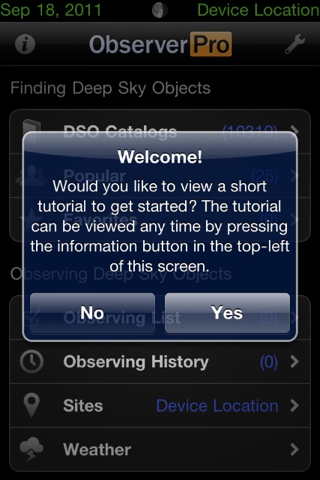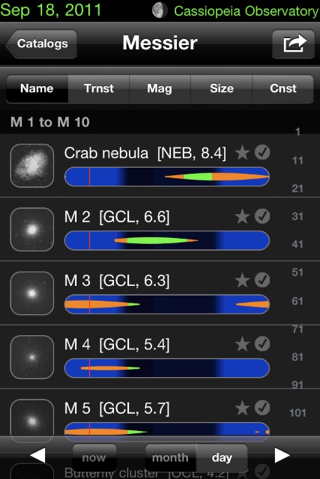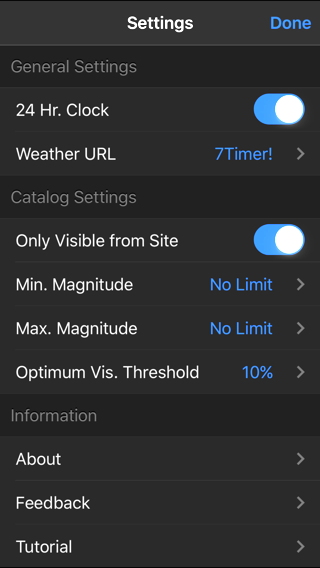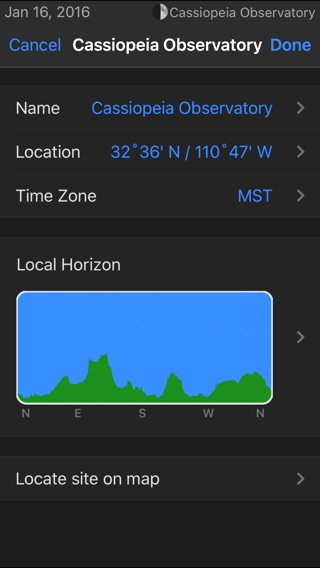Review - Observer Pro v1.1
Posted: 21 September 2011
Updated: 18 January 2016
 Observer Pro v1.1 for iOS
Observer Pro v1.1 for iOS
by Joshua Bury
$9.99
This review was written originally for version 1.0 in 2011. The app "broke" when iOS 8 was released. The developer has now released version 1.1 for compatibility with iOS 8 and 9. Jump to the version 1.1 discussion.
Version 1.0
Observer Pro ("OP" for short) is an observing/imaging planning app for the iPhone 3GS, iPhone 4, iPod touch (3rd generation), iPod touch (4th generation), and iPad, and requires iOS 4.2 or later. I was provided with a Redeem Code for Observer Pro and tested it on an iPhone 4 with the latest iOS. OP has many unique and valuable aids to setting up and using an observing list. For a brief overview, see the "Observer Pro" web site. I'll expand on some of the app's features in this review.
When you launch OP for the first time, you are offered the opportunity to view a short tutorial:

I recommend reading through it to learn how to use OP and what the various displays show. After I read the tutorial, I initially set up my observing site and then I configured the Settings:

Note the use of 7Timer! for weather information. However, you can enter any URL you prefer which will display a graphical image.
OP includes many object catalogs:


 Besides displaying a specific catalog, you can search for objects in all catalogs. That's handy to quickly find a specific object by name or ID. Notice what you don't see in the list of catalogs: solar system objects. Yes, the current version of Observer Pro only has Deep Sky Objects. And there is no facility to add non-DSO objects like planets or comets or any specific RA/Dec location to the observing list. Hopefully, this will be added in a future release. When you select a catalog, you get a display showing the list of objects in that catalog (seen at right). The display gives you a quick indication of the object's appearance and its current visibility. The graphic concisely shows you day and night time, visibility, altitude (depicted by the band thickness), and current time (thin red vertical line). You can add an object to your favorites or observing list. You can sort the catalog by Name, Transit time, object Magnitude, object Size, or object Constellation. You can change the date (month or day) forward and backward by using the arrows at the bottom. When you log an observation it is removed from the observing list and added to the history list. From the history list you can add it back to the observing list if desired; it is not removed from the history list. Logging an observation adds a checkmark to it. There is no time stamping (just the date is logged) nor any comments capability. These would be nice additions for a future version. Observing list entries can be deleted but there seemed to be no way to delete logged observations from the Observing History list. This should be added in the next release.
Besides displaying a specific catalog, you can search for objects in all catalogs. That's handy to quickly find a specific object by name or ID. Notice what you don't see in the list of catalogs: solar system objects. Yes, the current version of Observer Pro only has Deep Sky Objects. And there is no facility to add non-DSO objects like planets or comets or any specific RA/Dec location to the observing list. Hopefully, this will be added in a future release. When you select a catalog, you get a display showing the list of objects in that catalog (seen at right). The display gives you a quick indication of the object's appearance and its current visibility. The graphic concisely shows you day and night time, visibility, altitude (depicted by the band thickness), and current time (thin red vertical line). You can add an object to your favorites or observing list. You can sort the catalog by Name, Transit time, object Magnitude, object Size, or object Constellation. You can change the date (month or day) forward and backward by using the arrows at the bottom. When you log an observation it is removed from the observing list and added to the history list. From the history list you can add it back to the observing list if desired; it is not removed from the history list. Logging an observation adds a checkmark to it. There is no time stamping (just the date is logged) nor any comments capability. These would be nice additions for a future version. Observing list entries can be deleted but there seemed to be no way to delete logged observations from the Observing History list. This should be added in the next release.
If you tap the "Weather" button in the main display, you will see the 7Timer! (or other) weather forecast for your location:

One of the neatest features of Observer Pro is the ability to map out your local horizon using the device's camera, GPS, compass, and accelerometers (when available). This information is then used to determine object visibility at your observing site. You can configure separate sites, each with its own Local Horizon profile. You can also import and export horizon data (see the tutorial). To map your horizon, you simply move the crosshair along the obstacles using the camera and display:

 I opened the dome of my SkyShed POD and walked around my telescope, mapping my local horizon. The result is seen at the right. After I set up my observing location, I added some objects to the Observing List:
I opened the dome of my SkyShed POD and walked around my telescope, mapping my local horizon. The result is seen at the right. After I set up my observing location, I added some objects to the Observing List:

Selecting an object from your observing list or a catalog will show you information about that object:


Note: it may take several seconds (or minutes) for the "Year Visibility" chart to be displayed. While it is calculating, you will see the spinning pinwheel:

Tapping on each section will show you an expanded display of information:




At the top of every information page is the date, moon phase, and your selected Site.
Observer Pro is similar to AstroPlanner for Macintosh and Windows (click for my recent review). You can plan a night's session easily and accurately. The visibility displays are very useful, even if you don't plan to use the logging feature. Multiple sites and local horizon mapping make Observer Pro very versatile. If you need a great planning tool for your iOS device, Observer Pro is ideal.
LATE BREAKING NEWS: According to the developer, Version 1.0.1 has been submitted to Apple. It includes a couple bug fixes and minor improvements (removing entries from history is one).
The screen shots from version 1.0 (above) are still applicable to version 1.1. I have added a few screen shots for this review update as some of the interface look has changed and to show how Observer Pro v1.1 appears on my iPhone 6s Plus with iOS 9.2.
The main screen and Catalogs screen are essentially the same, with just a few minor changes in icons and look:



The Settings screen has an updated look with a few functional changes. One handy change is that the Night Mode has been moved to the main screen; you now tap the Moon icon in the upper right to toggle the red Night Mode display:


Since I had deleted v1.0.1 from my iPhone I no longer had my custom horizon. And even if I had been able to keep the older horizon data, there seems to be no way to import the old data into the new version. However, creating a custom horizon for your location is so simple you can do it in just a couple of minutes. You tap "Sites" on the main screen to bring up a list of your sites. On first use only "Device Location" is shown. The left screen below shows that I added "Cassiopeia Observatory" by clicking the "+" button at the bottom and entering appropriate data for my location. On the screen for my site I clicked the Local Horizon display to bring up the screen on the right below, which has instructions for using the device camera to scan your horizon.


The next two screen captures show the display before starting to scan my horizon and after completing it. Using the red crosshair you trace along obstacles on your horizon. You don't have to be exactly precise; you can see that I missed some of the trees.


Once you have created your local horizon, it appears for your site (left) and is used for object visibility displays (right):


I would frequently use Observer Pro while in the observatory to see what Deep Sky Objects were visible that night. When the app broke under iOS 8 I really came to miss using it. Great to have it back. Version 1.1 is a free update to all users of version 1.0 and 1.0.1. Now that it is compatible with the latest iOS and the newest iOS devices, Observer Pro is again a great planning tool that I highly recommend.
Update: version 1.1.1 has been submitted to the App Store. Per the Observer Pro Blog, v1.1.1 addresses two issues for users running iOS 8 on their devices.
Comments are welcome using Email. If you are on Twitter you can use the button below to tweet this review to your followers. Thanks.
Cassiopeia Observatory Home Page
Copyright ©2011, 2016 Michael L. Weasner / mweasner@me.com
URL = http://www.weasner.com/co/Reviews/2016/Observer_Pro/index.html

